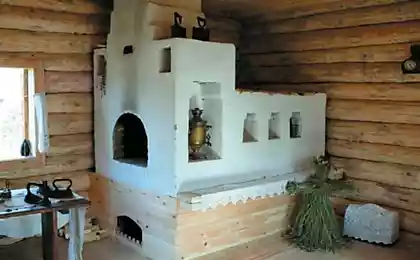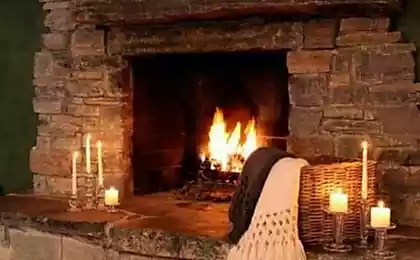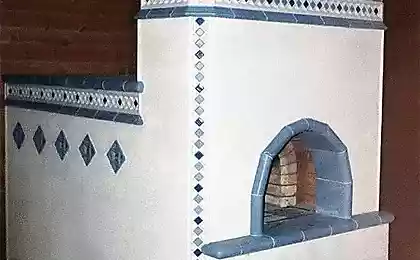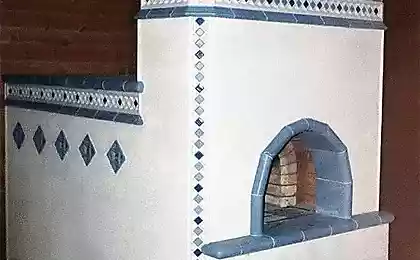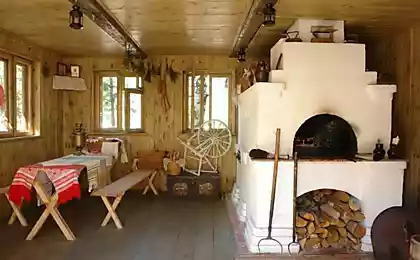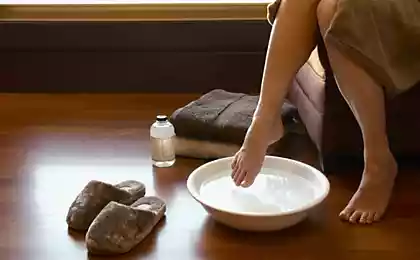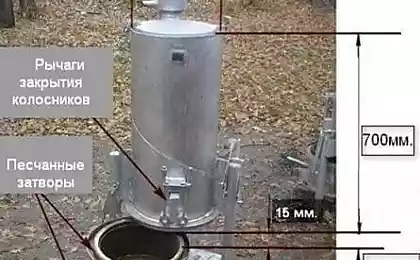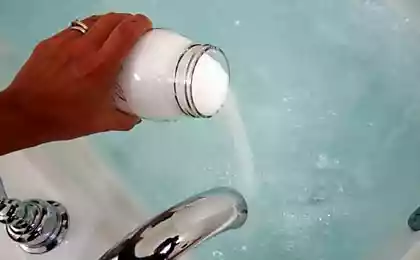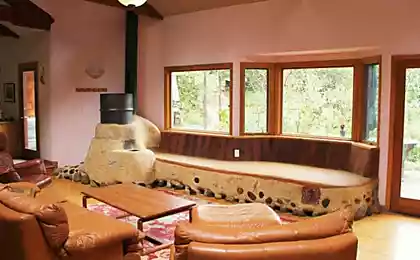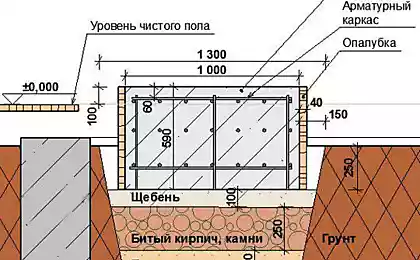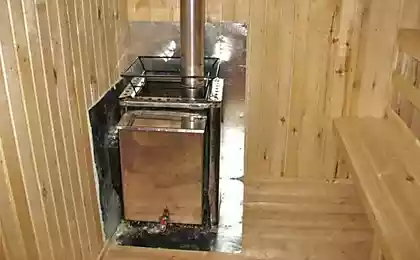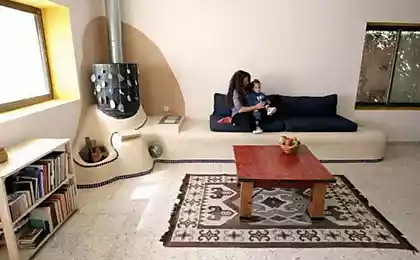248
How to make an oven from a cast-iron bath
Masters – craftsmen, of which there are enough in every city with an average population, have long mastered the manufacture of solid fuel boilers and furnaces from steel or brick. And most of their products work quite reliably and efficiently. And only cast iron, as a material for homemade heaters, until recently remained on the sidelines. But there is already an initiative and we in this article are ready to present it and discuss the question of how to make an oven from a cast-iron bath.
Homemade iron garden stovePreviously, the masters not without reason bypassed cast iron with their attention, although as a material for the manufacture of heating equipment, it is in high demand. The fact is that gray cast iron is difficult to process mechanically, and manufacturers of heating equipment to give it the necessary shape use the method of industrial casting. These technologies at home are not available, so you can take some cast-iron product for the manufacture of the oven and remake it, which was implemented by one of the home craftsmen. For this purpose, an old bath of cast iron, which has remained plenty since the Soviet era, is suitable.
Since this material is extremely hard and fragile, its processing requires not only a lot of patience, but also good locksmith skills. The old cast iron bath garden stove shown above is a good example of such skills and patience, and our task is to explain how this is done. First of all, you should take a corner grinder with a working diameter of 250 or 300 mm and stock up on metal cutting circles, then carefully measure half of the bathroom and apply a cut line. The width of the cut circle should be taken into account.
Preparation workThe next operation - cast-iron bath is cut in half, strictly along the line. The work is hard and long, but quite doable. When there are 2 halves of the product, they must be fastened together. Again, welding of cast iron parts at home is not available, so the halves are fastened to each other on bolts, and a steel sheet is laid between them, separating the fuel tank from the oven.
The master for this purpose took grooved sheet metal with a thickness of about 8 mm, you can follow his example. If there is an ordinary smooth metal of this thickness or a little more, it is also suitable, although it is better not to use a sheet thicker than 10 mm, this will affect the heating time of the oven. The workpiece from the sheet is better to cut in advance, but if the available metal is slightly larger than the size of the bathroom, then it can be done later, in place.
Another step on the way to the goal is marking and drilling fastening holes in a cast-iron bath and a metal gasket. Immediately make a reservation that you will need high-quality drills and the ability to sharpen them, because cast iron will not give up to you just like that, without a fight. To make 4 through holes, you will need to patiently grind the drill several times, while maintaining an angle of the working edge of at least 120o. We drill with different tools, from small diameter to large, at low rpm drills, periodically lubricating with engine oil.
And the last time-consuming operation - cutting a hole under the chimney. If you make it in a metal pad 8 mm thick is not very difficult, then the bathroom will have to tinker. It is best to cut in the place where the bathroom used to have a drain, it should be expanded to a diameter of 100 mm. When this operation is completed, you can start the assembly. First, the chimney must be welded to a metal sheet.
Any knowledgeable stove will tell you that this place is the weakest in the whole design of any steel heater, this joint burns out first. No exception and cast-iron oven from the bath, so it would be better to pass the pipe through the sheet and boil it from both sides.Assembly of the furnace body
When the element is ready, it is installed on the lower part of the bath, and the second part is placed on top. In the place of adjoining, the master used a special sealant as a sealant, but you can lay asbestos or basalt cardboard. After that, the holes are combined, the bolts are set up and their tightening is made. In this case, the stove body can be considered ready.
In order for a homemade oven from an old bath to acquire a finished look, it is necessary to cut and attach the front panel of metal, there is enough sheet thickness of 5-6 mm, and then make doors and a spikelet grille. All this design should be installed on a pedestal made of brick. In order not to heat the street, the metal surfaces of the combustion chamber and the oven need to be insulated with a layer of basalt fiber and lined with any convenient material.
Since the bathroom can be made not only garden stoves, but also heaters for different rooms, in the latter case, insulation of the body is not required so that the walls can freely give heat to the air environment of the room. Then the front panel will acquire a different look, and the brick base will have to be ennobled with finishing materials. At the same time, in front and behind the stove, brickwork should not be erected so that the furnace is freely washed with air. However, another craftsman can replace the brick support with a metal one, everything is in your hands.
Advantages and disadvantages
The main advantage that a cast-iron bath oven has, made with its own hands, is its almost zero cost. The main investment is your work, and you will have to put a lot of it. The second advantage is durability, it directly depends on the service life of the welded joints of the chimney and the front panel with doors, and the density of the adjoining elements. As for the bathroom, even enamel will not burn immediately.
For reference.In Soviet times, enamel based on silicon (quartz sand) was used for baths and kitchenware. It was applied to metal products in 2 layers (soil and glossy layer) and heated to a temperature of 860 ° C, so that the quartz sand melted, and then cooled by a certain technology. This kind of coating, protecting cast iron, served for decades and was destroyed only by heavy blows with a heavy object.
From the point of view of heat engineering, the efficiency of a homemade stove is unlikely to exceed 40% due to the direct exit of flue gases from the furnace outside, only part of the heat they transmit to the oven, and the rest goes into the atmosphere. For this reason, a similar design is used as an oven for a bath, where efficiency indicators are not so important, the main thing is temperature. However, only one half of the bath is taken and put on a base laid out of brick, and then the side walls are erected and a stone is arranged.
Half of the bath serves as a reliable and durable furnace, which will burn out very soon, and the heat will give the heater perfectly. As a result, less red ceramic brick will be spent on construction, which will significantly reduce the cost of the steam room as a whole. The only nuance is to properly fit two materials with different coefficients of thermal expansion in the bath oven - brick and cast iron. For this purpose, deformation seams are provided, where asbestos or basalt cardboard is laid.
ConclusionSuch non-standard solutions in the design of furnaces made with their own hands, amaze with their originality and simplicity. No one doubts the reliability and durability of a homemade cast iron oven from a Soviet bath, but it was invented and assembled by a master with a head and skillful hands at home. Every homeowner can make such products, and they will serve him faithfully for many years. Subscribe to our YouTube channel
www.youtube.com/channel/UCXd71u0w04qcwk32c8kY2BA/videos
Picture: cotlix.com/kak-sdelat-pech-iz-chugunnoj-vanny
P.S. And remember, just changing our consumption – together we change the world!
Join us on Facebook, VKontakte, Odnoklassniki
Picture: cotlix.com/kak-sdelat-pech-iz-chugunnoj-vanny
Homemade iron garden stovePreviously, the masters not without reason bypassed cast iron with their attention, although as a material for the manufacture of heating equipment, it is in high demand. The fact is that gray cast iron is difficult to process mechanically, and manufacturers of heating equipment to give it the necessary shape use the method of industrial casting. These technologies at home are not available, so you can take some cast-iron product for the manufacture of the oven and remake it, which was implemented by one of the home craftsmen. For this purpose, an old bath of cast iron, which has remained plenty since the Soviet era, is suitable.
Since this material is extremely hard and fragile, its processing requires not only a lot of patience, but also good locksmith skills. The old cast iron bath garden stove shown above is a good example of such skills and patience, and our task is to explain how this is done. First of all, you should take a corner grinder with a working diameter of 250 or 300 mm and stock up on metal cutting circles, then carefully measure half of the bathroom and apply a cut line. The width of the cut circle should be taken into account.
Preparation workThe next operation - cast-iron bath is cut in half, strictly along the line. The work is hard and long, but quite doable. When there are 2 halves of the product, they must be fastened together. Again, welding of cast iron parts at home is not available, so the halves are fastened to each other on bolts, and a steel sheet is laid between them, separating the fuel tank from the oven.
The master for this purpose took grooved sheet metal with a thickness of about 8 mm, you can follow his example. If there is an ordinary smooth metal of this thickness or a little more, it is also suitable, although it is better not to use a sheet thicker than 10 mm, this will affect the heating time of the oven. The workpiece from the sheet is better to cut in advance, but if the available metal is slightly larger than the size of the bathroom, then it can be done later, in place.
Another step on the way to the goal is marking and drilling fastening holes in a cast-iron bath and a metal gasket. Immediately make a reservation that you will need high-quality drills and the ability to sharpen them, because cast iron will not give up to you just like that, without a fight. To make 4 through holes, you will need to patiently grind the drill several times, while maintaining an angle of the working edge of at least 120o. We drill with different tools, from small diameter to large, at low rpm drills, periodically lubricating with engine oil.
And the last time-consuming operation - cutting a hole under the chimney. If you make it in a metal pad 8 mm thick is not very difficult, then the bathroom will have to tinker. It is best to cut in the place where the bathroom used to have a drain, it should be expanded to a diameter of 100 mm. When this operation is completed, you can start the assembly. First, the chimney must be welded to a metal sheet.
Any knowledgeable stove will tell you that this place is the weakest in the whole design of any steel heater, this joint burns out first. No exception and cast-iron oven from the bath, so it would be better to pass the pipe through the sheet and boil it from both sides.Assembly of the furnace body
When the element is ready, it is installed on the lower part of the bath, and the second part is placed on top. In the place of adjoining, the master used a special sealant as a sealant, but you can lay asbestos or basalt cardboard. After that, the holes are combined, the bolts are set up and their tightening is made. In this case, the stove body can be considered ready.
In order for a homemade oven from an old bath to acquire a finished look, it is necessary to cut and attach the front panel of metal, there is enough sheet thickness of 5-6 mm, and then make doors and a spikelet grille. All this design should be installed on a pedestal made of brick. In order not to heat the street, the metal surfaces of the combustion chamber and the oven need to be insulated with a layer of basalt fiber and lined with any convenient material.
Since the bathroom can be made not only garden stoves, but also heaters for different rooms, in the latter case, insulation of the body is not required so that the walls can freely give heat to the air environment of the room. Then the front panel will acquire a different look, and the brick base will have to be ennobled with finishing materials. At the same time, in front and behind the stove, brickwork should not be erected so that the furnace is freely washed with air. However, another craftsman can replace the brick support with a metal one, everything is in your hands.
Advantages and disadvantages
The main advantage that a cast-iron bath oven has, made with its own hands, is its almost zero cost. The main investment is your work, and you will have to put a lot of it. The second advantage is durability, it directly depends on the service life of the welded joints of the chimney and the front panel with doors, and the density of the adjoining elements. As for the bathroom, even enamel will not burn immediately.
For reference.In Soviet times, enamel based on silicon (quartz sand) was used for baths and kitchenware. It was applied to metal products in 2 layers (soil and glossy layer) and heated to a temperature of 860 ° C, so that the quartz sand melted, and then cooled by a certain technology. This kind of coating, protecting cast iron, served for decades and was destroyed only by heavy blows with a heavy object.
From the point of view of heat engineering, the efficiency of a homemade stove is unlikely to exceed 40% due to the direct exit of flue gases from the furnace outside, only part of the heat they transmit to the oven, and the rest goes into the atmosphere. For this reason, a similar design is used as an oven for a bath, where efficiency indicators are not so important, the main thing is temperature. However, only one half of the bath is taken and put on a base laid out of brick, and then the side walls are erected and a stone is arranged.
Half of the bath serves as a reliable and durable furnace, which will burn out very soon, and the heat will give the heater perfectly. As a result, less red ceramic brick will be spent on construction, which will significantly reduce the cost of the steam room as a whole. The only nuance is to properly fit two materials with different coefficients of thermal expansion in the bath oven - brick and cast iron. For this purpose, deformation seams are provided, where asbestos or basalt cardboard is laid.
ConclusionSuch non-standard solutions in the design of furnaces made with their own hands, amaze with their originality and simplicity. No one doubts the reliability and durability of a homemade cast iron oven from a Soviet bath, but it was invented and assembled by a master with a head and skillful hands at home. Every homeowner can make such products, and they will serve him faithfully for many years. Subscribe to our YouTube channel
www.youtube.com/channel/UCXd71u0w04qcwk32c8kY2BA/videos
Picture: cotlix.com/kak-sdelat-pech-iz-chugunnoj-vanny
P.S. And remember, just changing our consumption – together we change the world!
Join us on Facebook, VKontakte, Odnoklassniki
Picture: cotlix.com/kak-sdelat-pech-iz-chugunnoj-vanny
Mike moss: Salt, sugar and fat — how the food giants put us on the needle
From the history of Russian log hut: as was built by our ancestors
